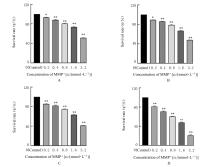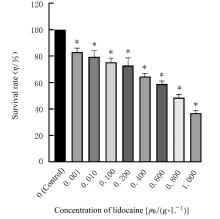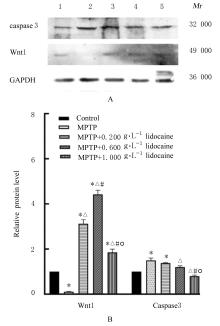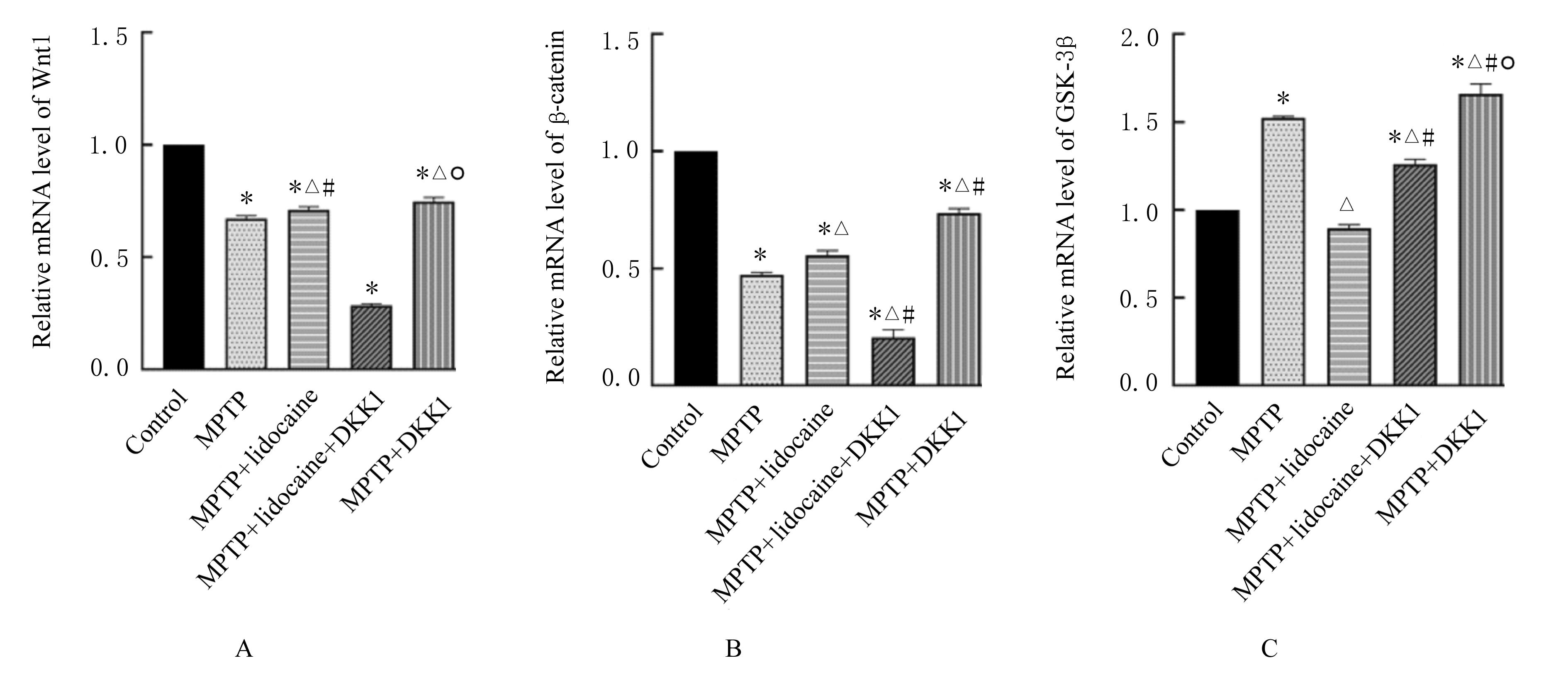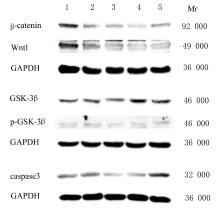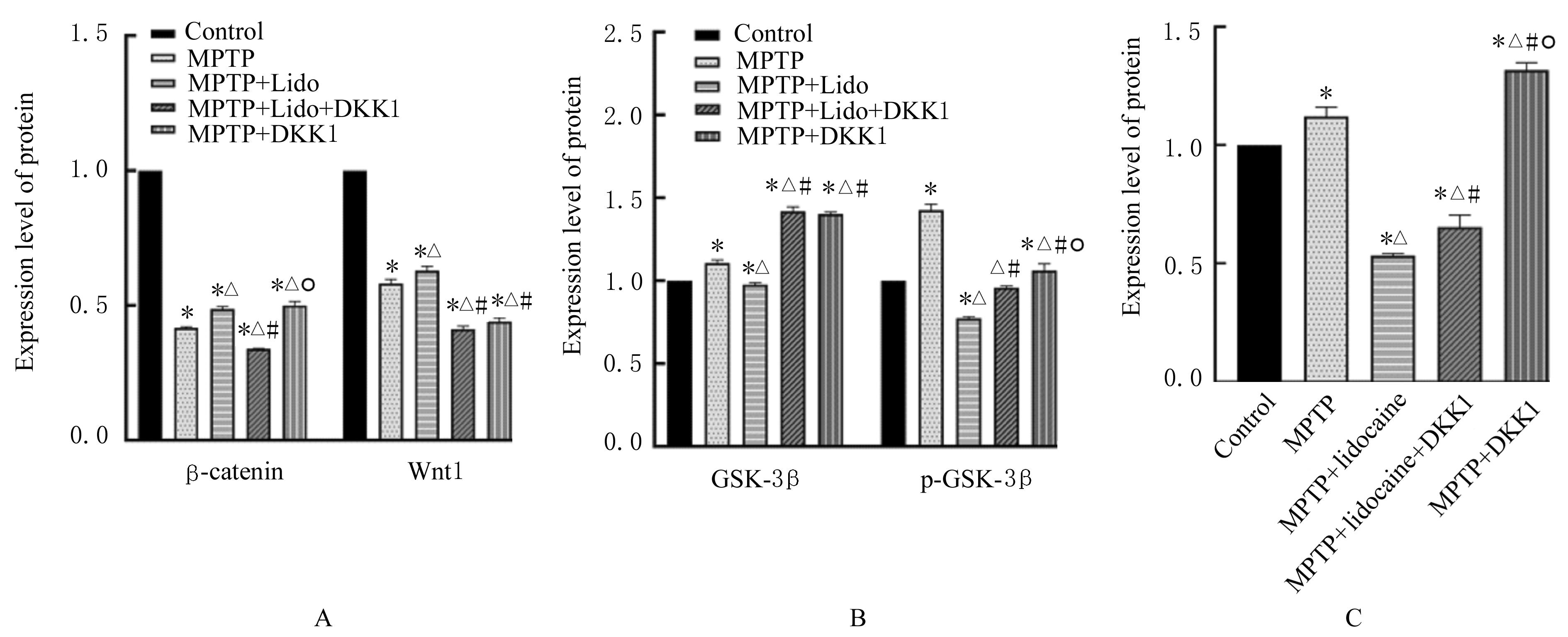Journal of Jilin University(Medicine Edition) ›› 2022, Vol. 48 ›› Issue (3): 638-647.doi: 10.13481/j.1671-587X.20220312
• Research in basic medicine • Previous Articles
Protective effect of lidocaine on PC12 cells in Parkinson’s disease model and its mechanism
Xiaochen HUANG1,Hao LI2,Baohua WANG1( ),Kai LI2,3(
),Kai LI2,3( )
)
- 1.Department of Anesthesiology,Affiliated Hospital,Changchun University of Traditional Chinese Medicine,Changchun 130117,China
2.Department of Labor Health and Environmental Health,School of Public Health,Jilin University,Changchun 130021,China
3.Department of Anesthesiololgy,China-Japan Union Hospital,Jilin University,Changchun 130033,China
-
Received:2021-09-22Online:2022-05-28Published:2022-06-21 -
Contact:Baohua WANG,Kai LI E-mail:wbhzyxx@163.com;likai@jlu.edu.cn
CLC Number:
- R614.1
Cite this article
Xiaochen HUANG,Hao LI,Baohua WANG,Kai LI. Protective effect of lidocaine on PC12 cells in Parkinson’s disease model and its mechanism[J].Journal of Jilin University(Medicine Edition), 2022, 48(3): 638-647.
share this article
Tab.2
Expression levels of Wnt1 and caspase 3 proteins in PC12 cells in various groups after treated with lidocaine for 6 h"
| Group | Wnt1 | caspase 3 |
|---|---|---|
| Control | 0.360±0.010 | 0.537±0.007 |
| MPTP | 0.035±0.005* | 0.815±0.045* |
| MPTP+0.200 g·L-1 lidocaine | 1.105±0.045*△ | 0.755±0.005* |
| MPTP+0.600 g·L-1 lidocaine | 1.575±0.055*△# | 0.660±0.020△ |
| MPTP+1.000 g·L-1 lidocaine | 0.630±0.008*△#○ | 0.436±0.02△#○ |
| F | 337.0 | 47.21 |
| P | <0.01 | <0.01 |
Tab.4
Levels of IL-1β,IL-6,and TNF-α in supernatant of PC12 cells in various groups [n=3,x±s, ρB/(ng·L-1)]"
| Group | IL-1β | IL-6 | TNF-α |
|---|---|---|---|
| Control | 1.173±0.011 | 98.732±2.576 | 3.135±0.437 |
| MPTP | 1.935±0.083* | 172.561±1.053* | 24.421±1.578* |
| MPTP+lidocaine | 1.203±0.033△ | 1005.020±4.722△ | 6.081±1.387△ |
| MPTP+lidocaine+DKK1 | 2.122±0.003*# | 157.634±0.726*# | 33.186±0.240*△# |
| MPTP+DKK1 | 2.834±0.011*△#○ | 161.525±4.615*# | 29.030±0.530*# |
| F | 92.38 | 292.3 | 1916 |
| P | <0.01 | <0.01 | <0.01 |
Tab.5
Expression levels of Wnt1,β-catenin,GSK-3β,p-GSK-3β,and caspase 3 proteins in PC12 cells in various groups"
| Group | Wnt1 | β-catenin | GSK-3β | p-GSK-3β | caspase 3 |
|---|---|---|---|---|---|
| Control | 0.961±0.008 | 0.975±0.005 | 0.517±0.004 | 0.545±0.005 | 0.544±0.006 |
| MPTP | 0.563±0.011* | 0.408±0.004* | 0.568±0.008* | 0.772±0.014* | 0.580±0.010* |
| MPTP+lidocaine | 0.609±0.011*△ | 0.476±0.010*△ | 0.503±0.004*△ | 0.419±0.004*△ | 0.288±0.003*△ |
| MPTP+lidocaine+DKK1 | 0.399±0.008*△# | 0.340±0.010*△# | 0.729±0.010*△# | 0.519±0.005△# | 0.351±0.021*△# |
| MPTP+DKK1 | 0.427±0.095*△# | 0.490±0.010*△# | 0.721±0.005*△# | 0.575±0.015*△# | 0.705±0.015*△#○ |
| F | 690.2 | 2 325 | 342.5 | 190.6 | 209.5 |
| P | <0.01 | <0.01 | <0.01 | <0.01 | <0.01 |
| 1 | BEITZ J M. Parkinson’s disease: a review[J]. Front Biosci (Schol Ed), 2014, 6(1): 65-74. |
| 2 | REN R T, SUN Y, ZHAO X, et al. Recent advances in biomarkers for Parkinson’s disease focusing on biochemicals, omics and neuroimaging[J]. Clin Chem Lab Med, 2015, 53(10): 1495-1506. |
| 3 | DORSEY E R, CONSTANTINESCU R, THOMPSON J P, et al. Projected number of people with Parkinson disease in the most populous nations, 2005 through 2030[J].Neurology,2007,68(5): 384-386. |
| 4 | KALIA L V, LANG A E. Parkinson’s disease[J]. Lancet, 2015, 386(9996): 896-912. |
| 5 | BASSANI T B, VITAL M A B F, RAUH L K. Neuroinflammation in the pathophysiology of Parkinson’s disease and therapeutic evidence of anti-inflammatory drugs[J]. Arq Neuropsiquiatr, 2015, 73(7): 616-623. |
| 6 | CIERI D, BRINI M, CALÌ T. Emerging (and converging) pathways in Parkinson’s disease: keeping mitochondrial wellness[J]. Biochem Biophys Res Commun, 2017, 483(4): 1020-1030. |
| 7 | SHEN L, JI H F. Low uric acid levels in patients with Parkinson’s disease: evidence from meta-analysis[J]. BMJ Open, 2013, 3(11): e003620. |
| 8 | BLAIR H A, DHILLON S. Safinamide: a review in Parkinson’s disease[J].CNS Drugs,2017,31(2): 169-176. |
| 9 | ASCHERIO A, SCHWARZSCHILD M A. The epidemiology of Parkinson’s disease: risk factors and prevention[J]. Lancet Neurol, 2016,15(12):1257-1272. |
| 10 | KEMPERMANN G. Adult neurogenesis: an evolutionary perspective[J]. Cold Spring Harb Perspect Biol, 2015, 8(2): a018986. |
| 11 | FONCK C, BAUDRY M. Toxic effects of MPP(+) and MPTP in PC12 cells independent of reactive oxygen species formation[J]. Brain Res, 2001, 905: 199-206. |
| 12 | MIN C C, CHO D I, KWON K J, et al. Novel regulatory mechanism of canonical Wnt signaling by dopamine D2 receptor through direct interaction with beta-catenin[J]. Mol Pharmacol, 2011, 80(1): 68-78. |
| 13 | 陈博文, 苏 飞, 冉继朋, 等. 利多卡因对大鼠SAH后神经细胞凋亡和迟发性脑血管痉挛的保护作用[J]. 神经解剖学杂志, 2019, 35(6): 641-645. |
| 14 | CHEN Z C, LI G L, LIU J. Autonomic dysfunction in Parkinson’s disease: implications for pathophysiology, diagnosis, and treatment[J]. Neurobiol Dis, 2020, 134: 104700. |
| 15 | PRESSE F, CARDONA B, BORSU L, et al. Lithium increases melanin-concentrating hormone mRNA stability and inhibits tyrosine hydroxylase gene expression in PC12 cells[J]. Brain Res Mol Brain Res, 1997, 52(2): 270-283. |
| 16 | BAYIR H, KAPRALOV A A, JIANG J, et al. Peroxidase mechanism of lipid-dependent cross-linking of synuclein with cytochrome C: protection against apoptosis versus delayed oxidative stress in Parkinson’s disease[J]. J Biol Chem, 2009, 284(23): 15951-15969. |
| 17 | KUMAR H, KOPPULA S, KIM I S, et al. Nuclear factor erythroid 2-related factor 2 signaling in Parkinson’s disease: a promising multi therapeutic target against oxidative stress, neuroinflammation and cell death[J]. CNS Neurol Disord Drug Targets, 2012, 11(8): 1015-1029. |
| 18 | BEAL M F. Experimental models of Parkinson’s disease[J]. Nat Rev Neurosci, 2001, 2(5): 325-334. |
| 19 | LANGSTON J W, IRWIN I. MPTP: current concepts and controversies[J]. Clin Neuropharmacol, 1986, 9(6): 485-507. |
| 20 | ZUO L, MOTHERWELL M S. The impact of reactive oxygen species and genetic mitochondrial mutations in Parkinson’s disease[J]. Gene, 2013, 532(1): 18-23. |
| 21 | JANG J, JUNG Y, KIM Y, et al. LPS-induced inflammatory response is suppressed by Wnt inhibitors, Dickkopf-1 and LGK974[J]. Sci Rep, 2017, 7: 41612. |
| 22 | JIN H B, YU J. Lidocaine protects H9c2 cells from hypoxia-induced injury through regulation of the MAPK/ERK/NF-κB signaling pathway[J]. Exp Ther Med, 2019, 18(5): 4125-4131. |
| 23 | WANG Z X, ZHAO Y, YU Y, et al. Effects of lncRNA SNHG20 on proliferation and apoptosis of non-small cell lung cancer cells through Wnt/β-catenin signaling pathway[J]. Eur Rev Med Pharmacol Sci, 2020, 24(1): 230-237. |
| 24 | LIN S W, JIN P P, SHAO C, et al. Lidocaine attenuates lipopolysaccharide-induced inflammatory responses and protects against endotoxemia in mice by suppressing HIF1α-induced glycolysis[J]. Int Immunopharmacol, 2020, 80: 106150. |
| 25 | KARNINA R, ARIF S K, HATTA M, et al. Molecular mechanisms of lidocaine[J]. Ann Med Surg (Lond), 2021, 69: 102733. |
| 26 | GORDON M D, NUSSE R. Wnt signaling: multiple pathways, multiple receptors, and multiple transcription factors[J]. J Biol Chem, 2006, 281(32): 22429-22433. |
| 27 | SAIKI S. The association of Parkinson’s disease pathogenesis with inflammation[J]. Rinsho Shinkeigaku, 2014, 54(12): 1125-1127. |
| 28 | 谭小平,丛盛日,向春晨,等.关注遗传性帕金森病[J].中国实用内科杂志,2022,42(4):283-289. |
| 29 | MARCHETTI B, TIROLO C, L'EPISCOPO F,et al. Parkinson’s disease, aging and adult neurogenesis: Wnt/β-catenin signalling as the key to unlock the mystery of endogenous brain repair[J]. Aging Cell, 2020, 19(3): e13101. |
| [1] | Yang ZHOU,Xuguang MI,Wenxing PU,Wentao WANG,Meng JING,Fankai MENG. Ameliorative effect of melatonin on oxidative stress of human neuroblastoma SHSY5Y cells induced by hydrogen peroxide and its mechanism [J]. Journal of Jilin University(Medicine Edition), 2022, 48(2): 340-347. |
| [2] | Leihua CUI,Yubo HOU,Chang SU,Minghe LI,Xin NIE. Effect of N-acetylcysteine on apoptosis of MC3T3-E1 cells induced by nicotine and its mechanism [J]. Journal of Jilin University(Medicine Edition), 2022, 48(1): 26-32. |
| [3] | Jie GONG,Zehua LEI,Yuanwei ZHANG,Xiong HUNANG,Bo DU,Zhixu WANG. Improvement effect of miR-490-3p over-expression on non-alcoholic fatty liver disease in rats and its mechanism [J]. Journal of Jilin University(Medicine Edition), 2021, 47(6): 1495-1501. |
| [4] | Lingna HAN,Chunlei WANG,Yongli CHANG,Li YUAN,Xiaojing LIU. Effect of electrical lesions of lateral habenular nucleus on spatial learning and memory functions in rats with Parkinson’s disease and its mechanism [J]. Journal of Jilin University(Medicine Edition), 2021, 47(5): 1108-1115. |
| [5] | Xinghua WANG,Hongjuan YANG,Xiuhong HU,Hongrei CUI,Baozhen XU,Danlu LI,Tao WANG,Yuwei GAO. Effects of N-acetyl-L-cysteine on oxidative stress and vascular endothelial function in rats with hyperuricemia and their mechanisms [J]. Journal of Jilin University(Medicine Edition), 2021, 47(5): 1209-1214. |
| [6] | Dimi ZHOU,Lu GAN,Lin CHEN,Chengfang ZHOU,Liang ZENG. Neuroprotective effect of Withaferin A on ischemic stroke rats and its mechanism [J]. Journal of Jilin University(Medicine Edition), 2021, 47(4): 919-925. |
| [7] | Zhanqi ZHAO,Chengjin ZHANG,Juan TIAN. Inhibitory effect of Ndfip1 on ferrion-induced neuronal apoptosis and its neuroprotective mechanism [J]. Journal of Jilin University(Medicine Edition), 2021, 47(2): 338-343. |
| [8] | Ruili ZHANG,Xiaoqing YANG,Xiaoge ZHANG,Huafeng GUO,Jihong ZHU. Effect of gestational diabetes mellitus on diaphragmatic function of newborn offsprings of rats [J]. Journal of Jilin University(Medicine Edition), 2021, 47(1): 133-138. |
| [9] | Hongfang LI,Shao YANG,Mohan CAO,Lili YUAN,Xiaojin LI,Caixing SHI,Zhuoya WANG,Bailiu YA. Improvement effect of curcumin on cerebral microcirculation disorder in hypercholesterolemia model rats and its mechanism [J]. Journal of Jilin University(Medicine Edition), 2021, 47(1): 53-58. |
| [10] | Xiaofeng LUO,Yao LI,Jiang HU,Chenhao ZHANG. Regulatory effect of gardenoside on sleep disorder in rats with Parkinson’s disease and its mechanism [J]. Journal of Jilin University(Medicine Edition), 2020, 46(6): 1177-1181. |
| [11] | ZHANG Cong, LIU Di, ZHANG Hanxue, ZHANG Hao, KONG Fanli, FENG Xianmin. Protective effect of ginsenoside on hydrogen peroxide-induced HepG2 cell injury [J]. Journal of Jilin University(Medicine Edition), 2020, 46(05): 985-991. |
| [12] | YANG Fan, LI Lihua. Effect of vitamin D receptor activation on hepatic fibrosis induced by bile duct ligation in mice and its mechanism [J]. Journal of Jilin University(Medicine Edition), 2020, 46(04): 722-727. |
| [13] | QIN Chao, DAI Xi, YANG Xiaoqiong, WANG Rongli, WANG Xing, LI Guoping. Intervention effect of honokiol on inflammatory response in lung tissue of asthma mice and its mechanism [J]. Journal of Jilin University(Medicine Edition), 2020, 46(02): 214-220. |
| [14] | GUO Xianghui, ZHENG Hui, WU Wei. Protetive effects of anemoside B4 on kidney tissue of rats with chronic renal failure and its mechanism [J]. Journal of Jilin University(Medicine Edition), 2020, 46(01): 90-95. |
| [15] | LI Jinhua, JIN Ying, LI Junfeng, LI Li. Effects of sesamin on abilities of learning and memory in AD model mice and their mechanisms [J]. Journal of Jilin University(Medicine Edition), 2019, 45(06): 1275-1280. |
|
||
